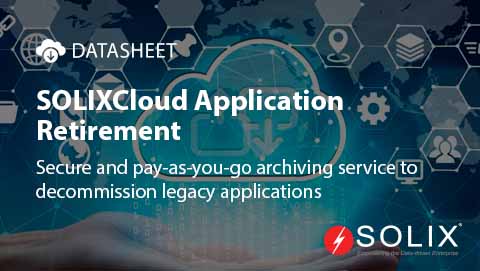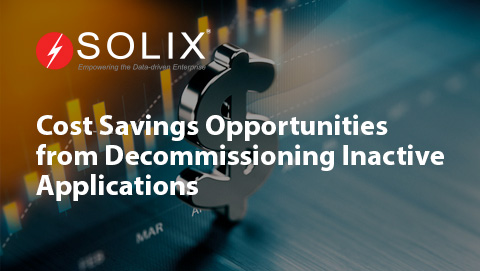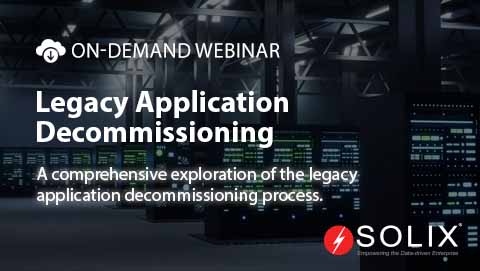Legacy System Migration Risks
Legacy system migration risks can often present significant challenges for businesses looking to modernize their IT infrastructure. These risks can include data loss, downtime, security vulnerabilities, and cost overruns. As a Cyber Governance & Risk Management leader, I have seen firsthand the impact that legacy system migration risks can have on an organization’s ability to effectively leverage technology for growth and innovation.
That’s why it is crucial for companies to carefully consider a strategic approach to managing legacy system migration risks in order to minimize potential pitfalls and ensure a smooth transition to new systems.
- One company that has been at the forefront of helping businesses address legacy system migration risks is solix. With their innovative solutions and expertise in data management, solix offers a range of tools and services designed to streamline the migration process and mitigate risks.
- By leveraging solix’s technology, companies can significantly reduce the likelihood of data loss, minimize downtime, and enhance security throughout the migration process.
- One real-world scenario where solix’s solutions could be particularly beneficial is in the decommissioning of legacy applications. Cost savings from legacy application decommissioning can be substantial, akin to walking through the data center and picking up one-hundred-dollar bills. A study by the Compliance, Governance, and Oversight Council revealed that companies could save an average of $40,000 annually by decommissioning inactive applications, with larger enterprise-class applications yielding savings upwards of $120,000 per year.
- By utilizing solix’s solixCloud Application Retirement and Decommissioning Service, organizations can effectively retire and decommission legacy applications at a low, fixed monthly cost. This not only helps reduce infrastructure costs but also ensures compliance with policy-based data retention, legal hold, and role-based access requirements.
- Additionally, solix’s application-specific accelerators and connectors for a variety of platforms make the migration process seamless and efficient.
- Another key benefit of solix’s solutions is centralized data governance and administration, which can help companies meet compliance objectives and optimize infrastructure.
- By implementing solix’s Enterprise Archiving Service, organizations can manage data growth, improve application performance, and enhance data security. The platform supports a wide range of data types and sources, including ERP systems, CRM applications, custom apps, and more, making it a versatile solution for companies of all sizes.
- In conclusion, by partnering with solix, companies can effectively mitigate legacy system migration risks and achieve significant cost savings in the process. Whether it’s decommissioning legacy applications or archiving less-active data, solix’s comprehensive suite of tools and services can help streamline the migration process and ensure a successful transition to modern systems.
So, if you’re looking to reduce the complexities and uncertainties associated with legacy system migration risks, consider reaching out to solix for a game-changing solution that can transform your business operations. Don’t miss this opportunity to revolutionize your approach to legacy system migration risks and unlock new possibilities for growth and innovation in your organization.
Don’t forget to learn more about how solix can help you tackle legacy system migration risks and drive your business forward by visiting solix.com.
Remember, by entering your email on our website, you could win $100 to put towards your next IT project. Don’t miss out on this chance to supercharge your business with solix’s groundbreaking solutions. Contact us today to learn more!
Legacy System Migration Risks
DISCLAIMER: THE CONTENT, VIEWS, AND OPINIONS EXPRESSED IN THIS BLOG ARE SOLELY THOSE OF THE AUTHOR(S) AND DO NOT REFLECT THE OFFICIAL POLICY OR POSITION OF SOLIX TECHNOLOGIES, INC., ITS AFFILIATES, OR PARTNERS. THIS BLOG IS OPERATED INDEPENDENTLY AND IS NOT REVIEWED OR ENDORSED BY SOLIX TECHNOLOGIES, INC. IN AN OFFICIAL CAPACITY. ALL THIRD-PARTY TRADEMARKS, LOGOS, AND COPYRIGHTED MATERIALS REFERENCED HEREIN ARE THE PROPERTY OF THEIR RESPECTIVE OWNERS. ANY USE IS STRICTLY FOR IDENTIFICATION, COMMENTARY, OR EDUCATIONAL PURPOSES UNDER THE DOCTRINE OF FAIR USE (U.S. COPYRIGHT ACT § 107 AND INTERNATIONAL EQUIVALENTS). NO SPONSORSHIP, ENDORSEMENT, OR AFFILIATION WITH SOLIX TECHNOLOGIES, INC. IS IMPLIED. CONTENT IS PROVIDED "AS-IS" WITHOUT WARRANTIES OF ACCURACY, COMPLETENESS, OR FITNESS FOR ANY PURPOSE. SOLIX TECHNOLOGIES, INC. DISCLAIMS ALL LIABILITY FOR ACTIONS TAKEN BASED ON THIS MATERIAL. READERS ASSUME FULL RESPONSIBILITY FOR THEIR USE OF THIS INFORMATION. SOLIX RESPECTS INTELLECTUAL PROPERTY RIGHTS. TO SUBMIT A DMCA TAKEDOWN REQUEST, EMAIL INFO@SOLIX.COM WITH: (1) IDENTIFICATION OF THE WORK, (2) THE INFRINGING MATERIAL’S URL, (3) YOUR CONTACT DETAILS, AND (4) A STATEMENT OF GOOD FAITH. VALID CLAIMS WILL RECEIVE PROMPT ATTENTION. BY ACCESSING THIS BLOG, YOU AGREE TO THIS DISCLAIMER AND OUR TERMS OF USE. THIS AGREEMENT IS GOVERNED BY THE LAWS OF CALIFORNIA.
-

-

-
 White Paper
White PaperCost Savings Opportunities from Decommissioning Inactive Applications
Download White Paper -

